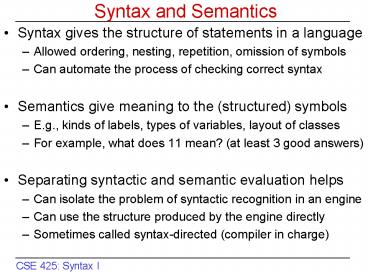Syntax and Semantics - PowerPoint PPT Presentation
Title:
Syntax and Semantics
Description:
Syntax and Semantics Syntax gives the structure of statements in a language Allowed ordering, nesting, repetition, omission of symbols Can automate the process of ... – PowerPoint PPT presentation
Number of Views:79
Avg rating:3.0/5.0
Title: Syntax and Semantics
1
Syntax and Semantics
- Syntax gives the structure of statements in a
language - Allowed ordering, nesting, repetition, omission
of symbols - Can automate the process of checking correct
syntax - Semantics give meaning to the (structured)
symbols - E.g., kinds of labels, types of variables, layout
of classes - For example, what does 11 mean? (at least 3 good
answers) - Separating syntactic and semantic evaluation
helps - Can isolate the problem of syntactic recognition
in an engine - Can use the structure produced by the engine
directly - Sometimes called syntax-directed (compiler in
charge)
2
Syntax and Lexical Structure
- Syntax gives the structure of statements in a
language - E.g., the format of tokens and how they can be
arranged - Lexical structure also describes how to recognize
them - Scanning obtains tokens from a stream characters
- E.g., whitespace delimited vs. regular-expression
based - Tokens include keywords, constants, symbols,
identifiers - Usually based on assumption of taking longest
substring - Parsing recognizes more complex expressions
- E.g., well-formed statements in logic,
arithmetic, etc. - Free-format languages ignore indentation, etc.
while fixed format languages have specific
restrictions/requirements
3
Scanning vs. Parsing Roles
- It is often possible to simplify a grammars
structure by making its tokens more sophisticated - For example, scanning for the terminal token
NUMBER vs. parsing for the non-terminal number ?
nonzerodigit digit - Such simplification delegates work to a scanner
- Often this is a good separation of concerns,
especially since scanning may appropriately
specialize it logic, etc. - E.g., a fairly general scanner built from
classification functions (which look for all
digits, all alphabetic, etc.) can be re-used or
refactored easily for scanning different grammars - E.g., the C11 ltregexgt library is worth studying
and using
4
Regular Expressions, DFAs, NDFAs
- Regular expressions capture lexical structure of
symbols that can be built using 3 composition
rules - Concatenation (ab) , selection (a b),
repetition (b) - Finite automata can recognize regular expressions
- Deterministic finite automata (DFAs) associate a
unique state with each sequence generated by a
regular expression - Non-deterministic finite automata (NDFAs) let
multiple states to be reached by the same input
sequence (adding choice) - Can generate a unique (minimal) DFA in 3 steps
- Generate NDFA from the regular expression (Scott
pp. 56) - Convert NDFA to (possibly larger) DFA (Scott pp.
56-58) - Minimize the DFA (Scott pp. 59) to get a unique
automaton - C11 ltregexgt library automates all this for you
5
Todays Studio Exercises
- Well code up some ideas from Scott Chapter
2.1-2.2 - Looking at mechanisms for recognizing tokens and
for parsing basic CFGs with straightforward
recursion - Next studio well look at more complicated
variations - Todays exercises are all in C
- Well write our own code, but check out the
ltregexpgt library too, since youll be allowed to
use it for lab assignments! - Please take advantage of the on-line tutorial and
reference manual pages that are linked on the
course web site - As always, please ask us for help as needed
- When done, email your answers to the course
account with Syntax Studio I in the subject line































